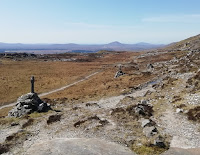Wishing all Club members a Happy Easter-Beannachtaí na Cásca oraibh.
Many people say they prefer Easter to Christmas. Both have their origins in pagan festivals and although maybe less known, there are certainly traditions recorded in the archives of the Folklore Commission for these next few days. Many seem more pagan than Christian, especially those associated with the sun.
This year, Easter falls at the very beginning of April. The first few days of this month are associated with the story of the
Bó Riabhach or the brindled cow. Once upon a time, March was shorter than it is now and at the beginning of old April, the Bó Riabhach began to complain about the harshness of the previous month. March at first took little notice, but as the complaining got worse, it decided to teach the cow a lesson. It duly borrowed three days from April, and made them so wet and cold that the Bó Riabhach perished. The story is recorded in another form in the archives of the Folklore Commission for Co. Roscommon, although the brindled cow meets the same fate. '
The three first days of April are called the Rábhach days. The old people say that there was a boastful old cow and when the month of April came she galloped round the field and boasted that she was sure to live when March was passed. When March was passed. When March heard this it got angry and borrowed three days from April and killed the old boastful cow.'
The Folklore Commission also records several stories associated with Eastertime, particularly Good Friday and Easter Sunday.
From Pollremon, Co, Galway, a school pupil wrote 'On Good Friday the people cut three bits of their hair. No blacksmith works and no one ploughs on that day. People perform their stations in the church also....From twelve to three o'clock on Good Friday people would not leave anything hanging up.'
In Co. Meath '
Eggs collected ...on Good Friday is the cure of a headache. No blood should be shed on Good Friday. When a child would be hung(a)ry on Good Friday they should be let cry three times before (they) it would get any-thing to eat. On Good Friday evening when the people would collect the eggs they would make the sign of the cross on the eggs with soot and them would be the first eggs to be eaten on Easter Sunday morning.'
In Claremorris, Co Mayo '...
some people cut a bit of their hair, for a sacrifice and people always try to sow crops on Good Friday because they never fail. It is very bad to cut your nails on Good Friday because they will never grow. The old people used to shave their horses that day.'
Also in Claremorris, '
On Easter Sunday morning some people look to the sun and they say that it dances about six o clock. On Sunday morning also it is a custom to eat three or four eggs for your breakfast. Long ago when the people fasted all during lent they made a feast on Easter. They went outside with a big pot and boiled eggs in it. They sat down and kept eating eggs until they sickened themselves. The woman of the house used to hide eggs in the garden. Everyone in the house would look for the eggs and as many eggs as they would get they could eat them for their breakfast.'
So, whatever your belief, or even if you have no belief at all, take heart from the ancestors and enjoy the next few days.
See www.dúchas.ie for further folklore from the Schools Collection.



